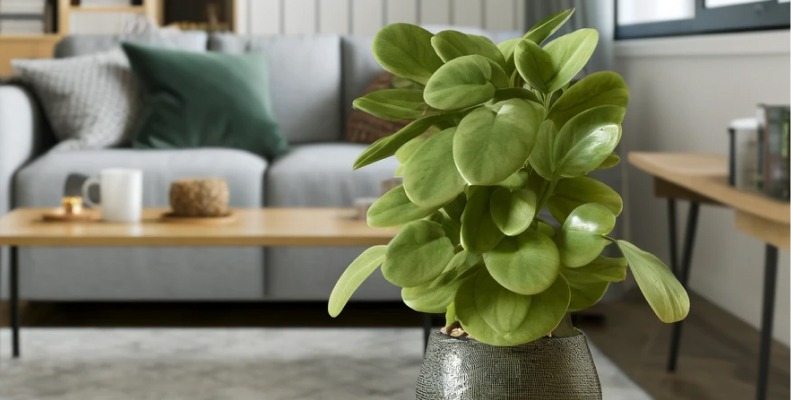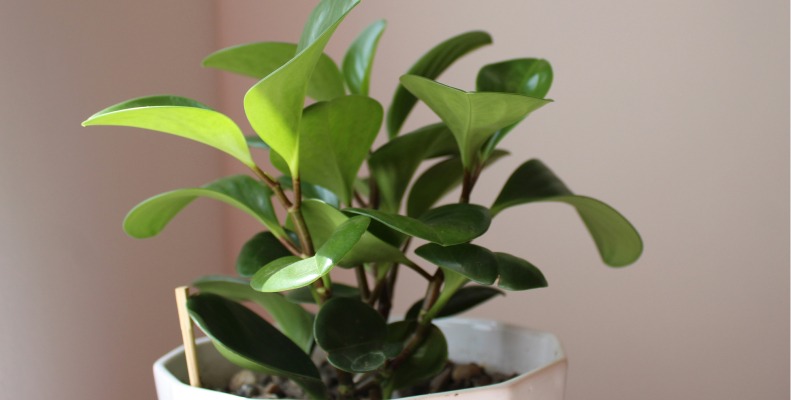The Baby Rubber Plant is an easy-to-care-for houseplant. It’s also known as the Peperomia Obtusifolia. It loves medium to bright, indirect light. But, it doesn’t like intense, direct sunlight which can hurt its leaves.
Water it every 1-2 weeks, letting the soil dry between. Keep the temperature between 65°F and 75°F. And avoid drafts or big changes in temperature. Also, it rarely gets bugs but you can use neem oil or insecticide if needed. The best part, it’s safe for pets because it’s not toxic.
Key Takeaways:
- Place the Baby Rubber Plant in medium to bright indirect light, avoiding intense, direct sunlight.
- Water the plant every 1-2 weeks, allowing the soil to dry out between waterings to prevent root rot.
- Maintain an average indoor temperature of 65°F to 75°F and protect the plant from drafts and extreme temperature fluctuations.
- Check for pests and treat with neem oil or insecticide if necessary.
- Enjoy the Baby Rubber Plant’s non-toxic nature, making it safe to have around pets.
Light Requirements for Baby Rubber Plant Care
Taking care of your Baby Rubber Plant means knowing what light it likes. These plants can do well in various lights. But, they really shine in certain situations.
Medium to bright indirect light:
For Baby Rubber Plants, think medium to bright indirect light. They love a spot that gets light but not directly. This could be near a window with a light curtain or light bouncing off a wall.
Putting your plant by a window with filtered sunlight is perfect. It gets the light it needs without the risk of burning from too much sun. Direct sunlight can harm the leaves, so it’s good to keep them safe.
These plants are fine in lower light, but don’t let them bake in the sun. Not lots of natural light? No problem. You can use grow lights to help them out.
Variegated cultivars may require slightly brighter light:
If your Baby Rubber Plant has different colored leaves, it may need a bit more light. This color change happens naturally and means the plant needs a bit extra care. Give them a bright, indirect light to look their very best.
Making sure your Baby Rubber Plant gets the right light helps it grow strong and look great in your home.
Watering and Humidity for Baby Rubber Plant Care
Keeping the right balance of water and humidity is key for baby rubber plants. It helps them grow well and keep their lovely leaves. Proper care makes baby rubber plants thrive.
Watering
Water baby rubber plants every 1-2 weeks. Let the soil dry in between. Too much water can cause problems like root rot. But too little water leads to wilting and lost leaves.
When you water, make sure it drips out the bottom. Then, wait for the soil to dry before the next watering. These plants like it on the dry side, so don’t worry about watering too little.
Humidity
Baby rubber plants love humid air. They do okay in normal home humidity, but more is better. This keeps their leaves from turning yellow.
It’s good to mist the leaves or use a humidifier. But don’t overdo it. Too much water in the air can harm your plant too.
Keep your plant away from drafts or heaters. They make the air too dry. That’s not good for your baby rubber plant.
To sum up, baby rubber plants need the right amount of water and humidity. Water every 1-2 weeks, and let the soil dry in between. Adding humidity by misting or using a humidifier is good too. Just remember, it’s about finding the right balance. This way, your plant will stay beautiful and lively for a long time.

Temperature and Fertilizing for Baby Rubber Plants
Baby Rubber Plants enjoy temperatures from 65°F to 75°F. It’s important to keep them from drafts and big temperature changes. This helps them stay healthy and grow well. A stable home means happy plants.
Fertilizing is also key for your baby rubber plants. You should feed them once or twice a month in spring and summer. A balanced liquid fertilizer works best when it’s mixed right.
Make sure the plants get just enough food. Don’t overdo it since their roots are small and sensitive. Stick to the directions on the fertilizer to avoid any problems.
Benefits of Fertilizing Baby Rubber Plants
Fertilizing helps baby rubber plants look great and grow strong. It brings several perks:
- Promotes overall plant growth and vigor
- Enhances leaf color and texture
- Stimulates the development of new leaves
- Improves resistance to diseases and pests
Always water your plants well before adding fertilizer. This keeps their roots safe and helps the soil take in the nutrients.
Did You Know? Baby rubber plants can benefit from organic fertilizers such as compost or worm castings. These natural alternatives provide slow-release nutrients and improve soil health over time.
Remember, proper temperature and regular feeding are vital for baby rubber plants. Follow these tips to keep your plants looking their best.
| Temperature and Fertilizing Guidelines | Summary |
|---|---|
| Temperature Range | 65°F to 75°F |
| Temperature Considerations | Avoid drafts and extreme temperature fluctuations |
| Fertilizing Frequency | Once or twice a month during the growing season |
| Fertilizer Type | Balanced liquid fertilizer |
| Fertilizer Dilution | Follow manufacturer’s instructions for dilution |
Remember, these suggestions are good to start with. But, watch how your plant responds and make any needed changes. Different plants may need different care.
Repotting and Common Issues for Baby Rubber Plants
Baby Rubber Plants have small roots and need repotting only every few years. Use a pot that’s not too big or deep. This helps avoid overwatering the plant.
Like any plant, Baby Rubber Plants can have problems. Overwatering can cause root rot. Let the soil dry out between waterings. Underwatering can make leaves fall off. So, make sure to water your plant regularly.
Problems can also come from cold drafts and too much sun. Cold drafts make the leaves brown. Keep your plant out of windy places. Too much sun can burn the leaves. Place your plant where it gets only filtered light.
Take good care of your Baby Rubber Plant to avoid these issues. Repot when needed. Watch out for too little or too much water. Also, protect it from cold drafts and strong sunlight. With care, your plant will stay beautiful for a long time.

